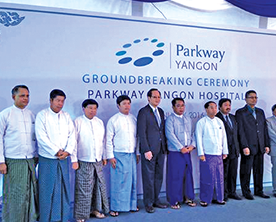Myanmar’s emerging medical device market has seen growing opportunities. The factors behind this include the increase in healthcare spending, upgrading of healthcare facilities and the growing demand for high quality diagnostics test results. With a large aging population and the increased incidence of lifestyle and chronic diseases, innovations that reduce or eliminate hospital stays will be critical. Remote healthcare, wireless enablement, minimally-invasive treatments are popular options. Increased focus on preventive care is forcing growing investments in products or solutions for home care, remote monitoring, tele-health and self-monitoring.
Medical experts say that the demand for medical equipment from emerging countries like Myanmar will outpace demand from developed countries in the next 5 years. While the U.S. and Europe markets are growing at 7-8% a year, Asian markets are growing at 25% a year. “Physicians increasingly are choosing being employed by big hospitals and other healthcare organizations. They are not much in favour of individual practices” says Dr. S.Wang, a senior gastroenterologist”. This shift is changing the manufacturer-buyer dynamics. Apart from doctors, hospital groups and insurance companies and government agencies have also emerged as entities that directly or indirectly influence medical device buying decisions.
“There is a lot of awareness about lifestyle diseases and people are familiar with new technologies through use of the Internet and consumer devices like MP3 players, smart phones and gaming devices, therefore, people are adopting more sophisticated devices to self-monitor their health conditions” says Dr. Sandeep Lakhtakia, a renowned Indian medical practitioner. . He adds, “The rapid technological developments through the use of devices such as glucose monitors, insulin delivery devices, nebulizers and oxygen concentrators is contributing to this trend”.
In developed countries, the medical devices industry is undergoing a strategic change with the focus moving from diagnosis to prevention. The demand for self-medication and home-based treatment is increasing, with more and more patients resorting to both the diagnosis and treatment of specific diseases at home. The use of remote communication technology to allow healthcare professionals to support home-based patients is further aiding to the preference for home and self-care. For consumers, this could mean convenience in time. This also reduces travel and healthcare costs, while for doctors; it could mean more efficient and effective healthcare, driven by patients who take greater responsibility for their own health.
According to a new market report published by Transparency Market Research, “There is a rise in demand for self-medication and home-based treatment. It’s due to the factor that increasing number of patients are choosing diagnosis and treatment of specific diseases at their own comfort (home).Selfcare medical devices play a major role in providing personal care that will ultimately help the patients or individuals to manage episodic acute and chronic illnesses. Healthcare is moving towards a precision based model of personal care. Increasing population of patient coupled with rising awareness of lifestyle disorders and rapid technological developments in medical devices have accentuated the growth of the self-care medical devices market, globally. “Chronic disaeases such as diabetes, asthma, blood pressure and other respiratory and cardiovascular diseases require continuous and regular lifelong monitoring” says Dr. Lakhtakia. “Rise in the number of people diagnosed with such diseases drives the demand for self-care medical devices. Factors such as rise in obese population are also propelling the growth of the self-care medical devices market”.
The report further says that around 200 million people in the world are affected by chronic diseases and approximately 85% of them require healthcare services for monitoring on a regular basis. Thus, self-care medical devices are witnessing fast adoption by consumers, to measure parameters on a regular basis and also cut down medical costs and save time.
Recent decades have seen a remarkable change in the delivery of health care services. Self-care devices such as blood glucose monitors, blood pressure monitors, temperature monitors, Holter monitors, pregnancy/fertility test kits, sleep apnea monitors, nebulizers and pedometers are used as primary care devices by patients, causing a shift in mode of treatment from hospital to home based healthcare. These medical devices enable a nurse, technician, or consumer — rather than a physician or a laboratory — to diagnose or monitor a medical condition. “The way health care is being delivered, it is setting a trend that means a lot for stakeholder and it also presents key questions for further discussion and research” says an employee of Golden Hawk International Ltd. located in Pazundaung, Myanmar that is working in medical equipment, hospital pharmaceuticals business activities. Companies in the USA and the Asia Pacific medical devices industry are more optimistic about their growth prospects than their counterparts in Europe. The tepid economic growth exhibited by European countries in the recent past is the chief reason for this. However, even in medical device markets that hold a positive outlook, sales gains are expected to remain modest.
The global blood pressure monitoring devices market was valued at USD 2.08 billion in 2014. This market is expected to grow at over 11% due to increasing incidences of hypertension due to changing lifestyle. In addition, growing awareness and demand for home use blood pressure (BP) monitors are expected to drive the industry growth in coming years. The demand for BP monitors is very high on account of growing geriatric population base and increasing risk of high blood pressure among wide population base due to rising incidences of obesity & sedentary lifestyle. According to the statistics published by the WHO, blood pressure was leading cause for 7.5 million deaths in 2008 and was anticipated to be a major risk factor for hemorrhagic stroke and coronary heart diseases in this decade. Similarly, global renal disease treatment devices market is also expected to grow at rapid pace due to rising incidences of chronic kidney disorders. According to Center for Disease Control and Prevention (CDC), nearly 70 million Americans suffered from high blood pressure in 2014, and it costs the nation around USD 46 billion every year including healthcare cost, medication and missed workdays. Asia Pacific on the other hand is expected to grow at rapid pace over the forecast period to reach around USD 900.0 million in 2022 owing to the presence of untapped opportunities, increasing investments by manufacturers, growing awareness levels and rising incidences of hypertension. Rapidly improving healthcare facilities and rising number of undiagnosed and untreated cases of high BP are key factors attributing to this regional market growth.










